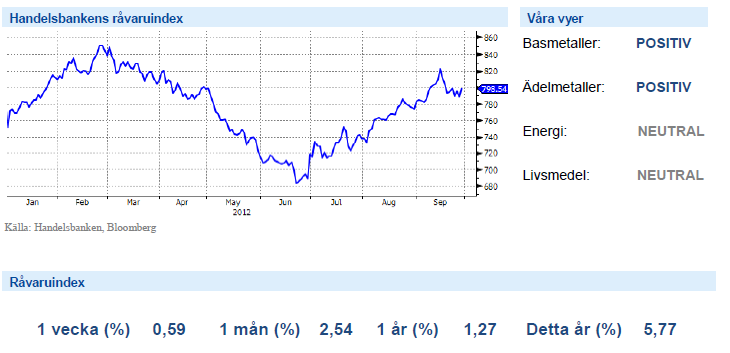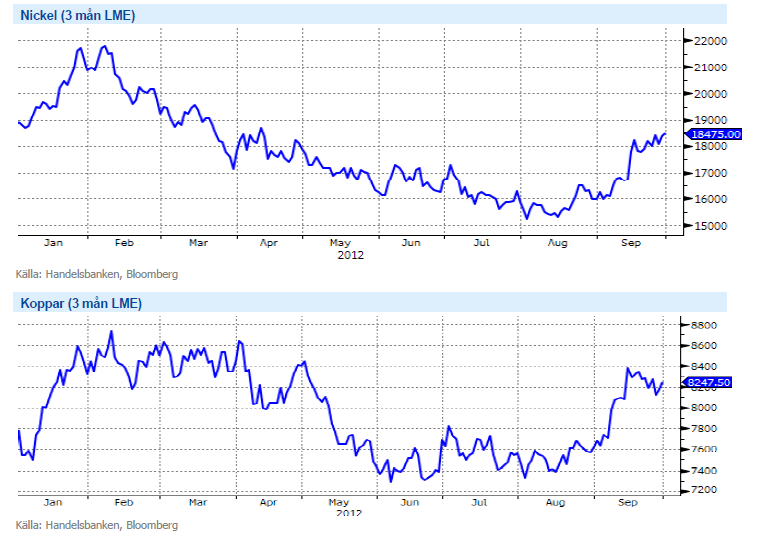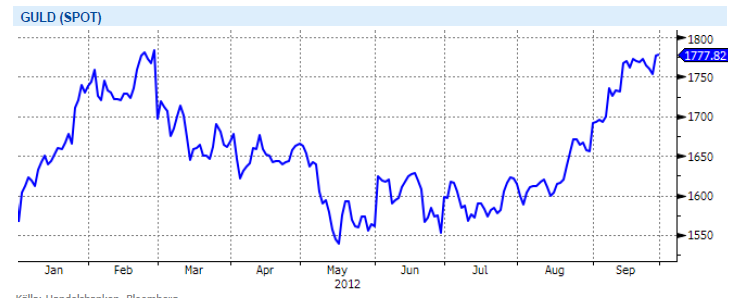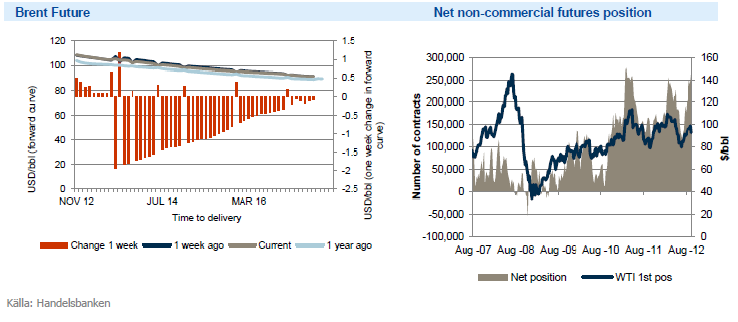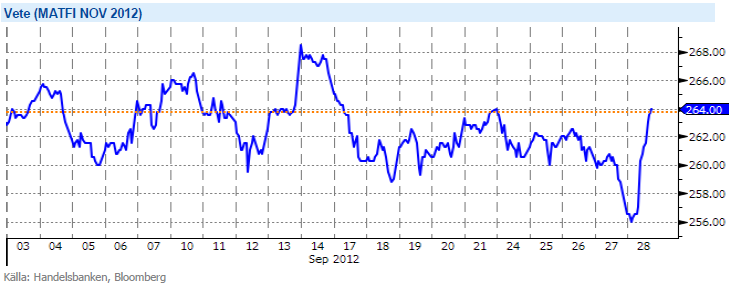Analys
SHB Råvarubrevet 28 september 2012
 Råvaror Allmänt
Råvaror Allmänt
Marknaden präglas av baksmälla
Under de senaste två veckorna får marknaderna sägas ha präglats av baksmälla efter augusti och septembers ”centralbanksorkestrerade obligationsköparpartaj”. Det hör inte till ovanligheterna att optimismen kommer av sig strax efter att nya stimulansprogram lanserats.
Så var det efter den officiella lanseringen av QE2, och så har det blivit även efter QE3, trots att den har ett ”öppet slut”. De individuella skillnaderna mellan de olika råvarorna börjar växa fram när marknaden inte enbart präglas av ”risk on/ risk off” handel. Mycket riskpremie har pyst ur oljan men ädel- och basmetaller håller emot.
Basmetallerna
Nickel visar på styrka
Resultatet efter veckans handel på basmetaller är något blandat där tenn och nickel är vinnare med en uppgång på 3% respektive 1,8%. Nickel handlas nu på nivåer vi inte sett sedan mitten av april och vi tror att trenden för nickel kommer fortsätta under hösten.
En ny ryktesflora av stimulanser kom ut under veckan. Denna gång riktade mot infrastruktur. Kinas makrodata har ännu inte vänt uppåt men spotpriset för de kinaexponerade metallerna har vänt skarpt uppåt de två senaste veckorna och indikerar att någonting håller på att hända i Kina. Ett negativt koppararbitrage mellan Shanghai och LME brukar i normala fall hålla Kineserna borta från spotmarknaden på metall och koncentrat så intressant att se om detta kan komma att pressa LME eller om Kineserna upprätthåller den höga importnivån av koncentrat (+14.4 YoY fram till september), metallerna avslutar i alla fall veckan väldigt starkt inför ”Golden Week” helgdagarna.
En ny ryktesflora av stimulanser kom ut under veckan. Denna gång riktade mot infrastruktur. Kinas makrodata har ännu inte vänt uppåt men spotpriset för de kinaexponerade metallerna har vänt skarpt uppåt de två senaste veckorna och indikerar att någonting håller på att hända i Kina. Vi tror på: BASMET H
Ädelmetaller
”Buy the rumour – sell the fact”
De två veckor som passerat sedan Fed annonserade QE3 har bjudit på en ganska lugn ädelmetall-marknad. Guldet har stigit med 5 dollar per uns, silver är i stort oförändrat medan platina fallit med 3 %. En viss känsla av den klassiska devisen ”buy the rumour – sell the fact” har smugit sig in, i den meningen att den stora prisuppgången i ädelmetaller ägde rum från det att Fed antydde ytterligare stimulanser till dess att de faktiskt annonserade dem.
Ytterligare oroligheter och strejker i Sydafrikan-ska gruvor har stängt ner produktionen motsvarande 40 % av landets totala kapacitet. Den senaste tidens oroligheter i platina-gruvor har lett till lönehöjningar i den delen av gruvnäringen, och detta riskerar leda till att man vill se samma lönehöjningar i guldgruvorna. Därför bör det finnas risk att strejkerna inom guldgruvorna sprider sig vidare i ett kort perspektiv.
Sydafrika är en stor nation inom guldproduktion, men inte alls så dominant som den varit historiskt. 1970 stod Sydafrika för nära 70 % av världens guldproduktion, en andel som successivt fallit till dagens 7 %. Största enskilda producentnation idag är Kina, följt av Australien och USA.
Även om det fysiska produktionsbortfallet i Sydafrika är signifikant, så tror vi att prisuppgången framöver kommer att drivas primärt av den penningpolitiska stimulans som världens största centralbanker just nu bjuder på.
Centralbankernas maniska kampanjer för att få fart på den globala ekonomin gynnar de ädla metallerna. Utöver stöd från centralbankerna så tilltar också utbudsstörningarna i Sydafrikas Platina och guldgruvor. Sammantaget är det en stark bild för ädelmetallerna. Vi tror på: ADELMET H
Energi
Välbalanserad fundamenta
Oljepriset halkade under USD 110/bbl tidigare i veckan på fördjupad oro kring Europa och amerikan-ska vinstvarningar. Irans kommentarer kring sina kärnanläggningar i kombination med överraskande amerikanska lagerminskningar balanserar nedgången något även om det senare passerade relativt obemärkt kan tyckas (totalt -3.41 miljoner fat), en effekt av minskad import snarare än ökad efterfrågan. Under det senaste prisfallet tycker vi att mycket av riskpremien kring konflikten mellan Israel och Iran har pyst ut. WTI oljan har historiskt sett tydligt påverkas av QE perioder medan effekten är mycket mindre på Brent. I närtid tycker vi att fundamenta är väl balanserat och håller oss neutrala.
Fundamenta håller nere elpriset och elmarknaden handlar i stort sett oförändrat över veckan där kvartalskontraktet Q1 2013 var nere och vände under 40 euro nivån som hastigast. Inledningsvis vått och milt väder i kombination med låga spottar som verkade för nedsidan, men i takt med stigande fossila bränslepriser, tysk el, och utsläppsrätter samt torrare varsel handlades kontraktet upp till förra veckans stängningsnivåer. Utsläppsmarknaden stöds av EU Kommissionens skepsis mot möjligheterna att använda krediter från de länder som inte vill skriva under Kyoto 2 protokollet. Även kolmarknaden ser ut att finna ett visst stöd men detta på väldigt låga nivåer så fokus förblir fortsatt på vädret om det ska till någon kraftig rörelse. Senaste väderprognosen visar på normal nederbörd om ca 6 TWh de kommande 10 dagarna vilket därmed bör hålla energibalansen kvar kring nuvarande nivåer om + 12 TWh. Fokus kommer successivt flyttas mot den kallare årstiden och därmed kommer kärnkraften åter att diskuteras. Just nu står 4,5 av våra tio reaktorer helt stilla och det finns en klar risk inför vintern men just nu ser vädret ut att hålla nere marknaden ett tag till.
Fundamenta håller nere elpriset även om fokus successivt flyttas mot den kallare årstiden och därmed kommer kärnkraften åter att diskuteras. Just nu står 4,5 av våra tio reaktorer helt stilla och det finns en klar risk inför vintern. Vi avvaktar dock att marknaden ska vända före vi tror på starkt stigande elpriser.
Livsmedel
USDA rapport överraskade
USA vetet fortsätter sin resa nedåt i den fallande kanal som Chicago har handlats i de senaste 11 veckorna. Fallande majs är det huvudsakliga skälet till att vete är svagt. Det har pratats/spekulerats mycket kring att efterfrågan på det amerikanska vetet ska bli stark under den kommande export/importperioden världen över, främst som en konsekvens av sämre export från svarta havsregionen. Före det händer verkar dock inte vete få mycket stöd kring nuvarande nivåer. Frankrike har överraskat och ökat exporten. Samtidigt har de höga priserna i Ryssland gjort att exporten där hr minskat och det verkar som att Ryska politiker kan låta prismekanismen sköta lagersaldot i år.
Fallet för majs kan nu summeras till 1,20 USD/bu se-dan toppen i augusti. Fallande export i USA på nuvarande priser och det säsongsmässiga trycket nedåt på priserna mitt under skörden är de viktigaste faktorerna bakom prisfallet. Det finns säkert skäl för USDA att se över sina estimat på USA export, givet senaste tidens svaga export.
Få nyheter på sojamarknaden denna vecka men den starka trenden nedåt för sojan har fått EU:s rapspris att vända söderut. Raps har fallit 40 EUR på två veckor, vilket motsvarar 8 %. Detta är fortfarande mindre än de 11 % som sojan tappat under samma period och trycket nedåt på rapspriset i Paris kan därför bestå. Kommande vecka är semestervecka i Kina och spannmålsbörserna där är stängda och kommer inte att ge någon vägledning för USA och Europa.
Dagens USDA rapport för det tredje kvartalet 2012 var något överraskande och marknaden reagerar starkt mot slutet där Vete handlas upp på två veckors högsta nivå (se nedan). Lagersiffrorna på både Vete och Majs kom in en bra bit under våra och marknadens förväntningar, 2,104 miljoner bushels för Vete (162 miljoner under förväntan) och 988 miljoner bushels för Majs (178 miljoner under förväntan) samtidigt som Sojalagren visar 169 miljoner bushels 39 miljoner över förväntan.
Handelsbankens Råvaruindex
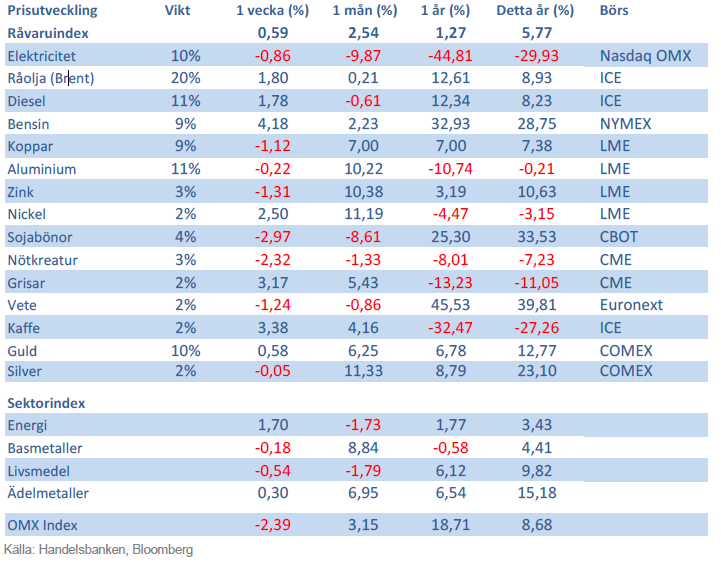
Handelsbankens råvaruindex består av de underliggande indexen för respektive råvara. Vikterna är bestämda till hälften från värdet av global produktion och till hälften från likviditeten i terminskontrakten.
[box]SHB Råvarubrevet är producerat av Handelsbanken och publiceras i samarbete och med tillstånd på Råvarumarknaden.se[/box]
Ansvarsbegränsning
Detta material är producerat av Svenska Handelsbanken AB (publ) i fortsättningen kallad Handelsbanken. De som arbetar med innehållet är inte analytiker och materialet är inte oberoende investeringsanalys. Innehållet är uteslutande avsett för kunder i Sverige. Syftet är att ge en allmän information till Handelsbankens kunder och utgör inte ett personligt investeringsråd eller en personlig rekommendation. Informationen ska inte ensamt utgöra underlag för investeringsbeslut. Kunder bör inhämta råd från sina rådgivare och basera sina investeringsbeslut utifrån egen erfarenhet.
Informationen i materialet kan ändras och också avvika från de åsikter som uttrycks i oberoende investeringsanalyser från Handelsbanken. Informationen grundar sig på allmänt tillgänglig information och är hämtad från källor som bedöms som tillförlitliga, men riktigheten kan inte garanteras och informationen kan vara ofullständig eller nedkortad. Ingen del av förslaget får reproduceras eller distribueras till någon annan person utan att Handelsbanken dessförinnan lämnat sitt skriftliga medgivande. Handelsbanken ansvarar inte för att materialet används på ett sätt som strider mot förbudet mot vidarebefordran eller offentliggörs i strid med bankens regler.
Analys
Fear that retaliations will escalate but hopes that they are fading in magnitude

Brent crude spikes to USD 90.75/b before falling back as Iran plays it down. Brent crude fell sharply on Wednesday following fairly bearish US oil inventory data and yesterday it fell all the way to USD 86.09/b before a close of USD 87.11/b. Quite close to where Brent traded before the 1 April attack. This morning Brent spiked back up to USD 90.75/b (+4%) on news of Israeli retaliatory attack on Iran. Since then it has quickly fallen back to USD 88.2/b, up only 1.3% vs. ydy close.

The fear is that we are on an escalating tit-for-tat retaliatory path. Following explosions in Iran this morning the immediate fear was that we now are on a tit-for-tat escalating retaliatory path which in the could end up in an uncontrollable war where the US unwillingly is pulled into an armed conflict with Iran. Iran has however largely diffused this fear as it has played down the whole thing thus signalling that the risk for yet another leg higher in retaliatory strikes from Iran towards Israel appears low.
The hope is that the retaliatory strikes will be fading in magnitude and then fizzle out. What we can hope for is that the current tit-for-tat retaliatory strikes are fading in magnitude rather than rising in magnitude. Yes, Iran may retaliate to what Israel did this morning, but the hope if it does is that it is of fading magnitude rather than escalating magnitude.
Israel is playing with ”US house money”. What is very clear is that neither the US nor Iran want to end up in an armed conflict with each other. The US concern is that it involuntary is dragged backwards into such a conflict if Israel cannot control itself. As one US official put it: ”Israel is playing with (US) house money”. One can only imagine how US diplomatic phone lines currently are running red-hot with frenetic diplomatic efforts to try to defuse the situation.
It will likely go well as neither the US nor Iran wants to end up in a military conflict with each other. The underlying position is that both the US and Iran seems to detest the though of getting involved in a direct military conflict with each other and that the US is doing its utmost to hold back Israel. This is probably going a long way to convince the market that this situation is not going to fully blow up.
The oil market is nonetheless concerned as there is too much oil supply at stake. The oil market is however still naturally concerned and uncomfortable about the whole situation as there is so much oil supply at stake if the situation actually did blow up. Reports of traders buying far out of the money call options is a witness of that.
Analys
Fundamentals trump geopolitical tensions

Throughout this week, the Brent Crude price has experienced a decline of USD 3 per barrel, despite ongoing turmoil in the Middle East. Price fluctuations have ranged from highs of USD 91 per barrel at the beginning of the week to lows of USD 87 per barrel as of yesterday evening.

Following the release of yesterday’s US inventory report, Brent Crude once again demonstrated resilience against broader macroeconomic concerns, instead focusing on underlying market fundamentals.
Nevertheless, the recent drop in prices may come as somewhat surprising given the array of conflicting signals observed. Despite an increase in US inventories—a typically bearish indicator—we’ve also witnessed escalating tensions in the Middle East, coupled with the reinstatement of US sanctions on Venezuela. Furthermore, there are indications of impending sanctions on Iran in response to the recent attack on Israel.
Treasury Secretary Janet Yellen has indicated that new sanctions targeting Iran, particularly aimed at restricting its oil exports, could be announced as early as this week. As previously highlighted, we maintain the view that Iran’s oil exports remain vulnerable even without further escalation of the conflict. It appears that Israel is exerting pressure on its ally, the US, to impose stricter sanctions on Iran, an action that is unfolding before our eyes.
Iran’s current oil production stands at close to 3.2 million barrels per day. Considering additional condensate production of about 0.8 million barrels per day and subtracting domestic demand of roughly 1.8 million barrels per day, the net export of Iranian crude and condensate is approximately 2.2 million barrels per day.
However, the uncertainty surrounding the enforcement of such sanctions casts doubt on the likelihood of a complete ending of Iranian exports. Approximately 80% of Iran’s exports are directed to independent refineries in China, suggesting that US sanctions may have limited efficacy unless China complies. The prospect of China resisting US pressure on its oil imports from Iran poses a significant challenge to US sanctions enforcement efforts.
Furthermore, any shortfall resulting from sanctions could potentially be offset by other OPEC nations with spare capacity. Saudi Arabia and the UAE, for instance, can collectively produce an additional almost 3 million barrels of oil per day, although this remains a contingency measure.
In addition to developments related to Iran, the Biden administration has re-imposed restrictions on Venezuelan oil, marking the end of a six-month reprieve. This move is expected to impact flows from the South American nation.
Meanwhile, US crude inventories (excluding SPR holdings) surged by 2.7 million barrels last week (page 11 attached), reaching their highest level since June of last year. This increase coincided with a decline in measures of fuel demand (page 14 attached), underscoring a slightly weaker US market.
In summary, while geopolitical tensions persist and new rounds of sanctions are imposed, our market outlook remains intact. We maintain our forecast of an average Brent Crude price of USD 85 per barrel for the year 2024. In the short term, however, prices are expected to hover around the USD 90 per barrel mark as they navigate through geopolitical uncertainties and fundamental factors.
Analys
Brace for Covert Conflict

In the past two trading days, Brent Crude prices have fluctuated between highs of USD 92.2 per barrel and lows of USD 88.7 per barrel. Despite escalation tensions in the Middle East, oil prices have remained relatively stable over the past 24 hours. The recent barrage of rockets and drones in the region hasn’t significantly affected market sentiment regarding potential disruptions to oil supply. The key concern now is how Israel will respond: will it choose a strong retaliation to assert deterrence, risking wider regional instability, or will it revert to targeted strikes on Iran’s proxies in Lebanon, Syria, Yemen, and Iraq? While it’s too early to predict, one thing is clear: brace for increased volatility, uncertainty, and speculation.

Amidst these developments, the market continues to focus on current fundamentals rather than unfolding geopolitical risks. Despite Iran’s recent attack on Israel, oil prices have slid, reflecting a sideways or slightly bearish sentiment. This morning, oil prices stand at USD 90 per barrel, down 2.5% from Friday’s highs.
The attack
Iran’s launch of over 300 rockets and drones toward Israel marks the first direct assault from Iranian territory since 1991. However, the attack, announced well in advance, resulted in minimal damage as Israeli and allied forces intercepted nearly all projectiles. Hence, the damage inflicted was limited. The incident has prompted US President Joe Biden to urge Israel to exercise restraint, as part of broader efforts to de-escalate tensions in the Middle East.
Israel’s response remains uncertain as its war cabinet deliberates on potential courses of action. While the necessity of a response is acknowledged, the timing and magnitude remain undecided.
The attack was allegedly in retaliation for an Israeli airstrike on Iran’s consulate in Damascus, resulting in significant casualties, including a senior leader in the Islamic Revolutionary Guard Corps’ elite Quds Force. It’s notable that this marks the first direct targeting of Israel from Iranian territory, setting the stage for heightened tensions between the two nations.
Despite the scale of the attack, the vast majority of Iranian projectiles were intercepted before reaching Israeli territory. However, a small number did land, causing minor damage to a military base in the southern region.
President Biden swiftly condemned Iran’s actions and pledged to coordinate a diplomatic response with leaders from the G7 nations. The US military’s rapid repositioning of assets in the region underscores the seriousness of the situation.
Iran’s willingness to escalate tensions further depends on Israel’s response, as indicated by General Mohammad Bagheri, chief of staff of the Iranian armed forces. Meanwhile, speculation about a retaliatory attack from Israel persists.
Looking ahead, key questions remain unanswered. Will Iran launch additional attacks? How will Israel respond, and what implications will it have for the region? Moreover, how will Iran’s allies react to the escalating tensions?
Given the potential for a full-scale war between Iran and Israel, concerns about its impact on global energy markets are growing. Both the United States and China have strong incentives to reduce tensions in the region, given the destabilizing effects of a regional conflict.
Our view in conclusion
The recent escalation between Iran and Israel underscores the delicate balance of power in the volatile Middle East. With tensions reaching unprecedented levels and the specter of further escalation looming, the potential for a full-blown conflict cannot be understated. The ramifications of such a scenario would be far-reaching and could have significant implications for regional stability and global security.
Turning to the oil market, there has been much speculation about the possibility of a full-scale blockade of the Strait of Hormuz in the event of further escalation. However, at present, such a scenario remains highly speculative. Nonetheless, it is crucial to note that Iran’s oil production and exports remain at risk even without further escalation. Currently producing close to 3.2 million barrels per day, Iran has significantly increased its production from mid-2020 levels of 1.9 million barrels per day.
In response to the recent attack, Israel may exert pressure on its ally, the US, to impose stricter sanctions on Iran. The enforcement of such sanctions, particularly on Iranian oil exports, could result in a loss of anywhere between 0.5 million to 1 million barrels per day of oil supply. This would likely keep the oil market in deficit for the remainder of the year, contradicting the Biden administration’s wish to maintain oil and gasoline prices at sustainable levels ahead of the election. While other OPEC nations have spare capacity, utilizing it would tighten the global oil market even further. Saudi Arabia and the UAE, for example, could collectively produce an additional almost 3 million barrels of oil per day if necessary.
Furthermore, both Iran and the US have expressed a desire to prevent further escalation. However, much depends on Israel’s response to the recent barrage of rockets. While Israel has historically refrained from responding violently to attacks (1991), the situation remains fluid. If Israel chooses not to respond forcefully, the US may be compelled to promise stronger enforcement of sanctions on Iranian oil exports. Consequently, Iranian oil exports are at risk, regardless of whether a wider confrontation ensues in the Middle East.
Analyzing the potential impact, approximately 2.2 million barrels per day of net Iranian crude and condensate exports could be at risk, factoring in Iranian domestic demand and condensate production. The effectiveness of US sanctions enforcement, however, remains uncertain, especially considering China’s stance on Iranian oil imports.
Despite these uncertainties, the market outlook remains cautiously optimistic for now, with Brent Crude expected to hover around the USD 90 per barrel mark in the near term. Navigating through geopolitical tensions and fundamental factors, the oil market continues to adapt to evolving conflicts in the Middle East and beyond.
-

 Nyheter2 veckor sedan
Nyheter2 veckor sedanGuldpriset når nytt all time high och bryter igenom 2300 USD
-

 Nyheter4 veckor sedan
Nyheter4 veckor sedanGuld toppar 2200 USD per uns
-

 Nyheter3 veckor sedan
Nyheter3 veckor sedanLundin Mining får köprekommendation av BMO
-

 Nyheter4 veckor sedan
Nyheter4 veckor sedanVertikal prisuppgång på kakao – priset toppar nu 9000 USD
-

 Nyheter4 veckor sedan
Nyheter4 veckor sedanKaffepriserna stiger på lågt utbud och stark efterfrågan
-

 Nyheter2 veckor sedan
Nyheter2 veckor sedanCentralbanker fortsatte att köpa guld under februari
-

 Nyheter2 veckor sedan
Nyheter2 veckor sedanHur mår den svenska skogsbraschen? Två favoritaktier
-

 Nyheter2 veckor sedan
Nyheter2 veckor sedanKakaomarknaden är extrem för tillfället


